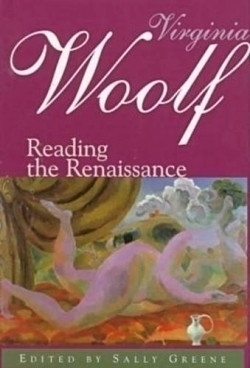Virginia Woolf
Reading the Renaissance
The renaissance of Virginia Woolf still blooms. Successively reborn into our polemical age of interdisciplinary feminist studies, her witty and passionate rebellion against Victorian/Edwardian cultural, literary and sexual patriarchy has acquired an accent formidably American. But if “decentered interpretive polyphony” of a village pageant of English history does not quite scan as “the words of one syllable, without larding, stuffing or cant” envisioned by its longsuffering director Miss La Trobe in Between the Acts (1941), still, that essay’s incisive comparison of Woolf and T.S. Eliot’s rival readings of the Elizabethan age amply repays its audience in Virginia Woolf: Reading the Renaissance, a collection of ten scholars? essays on Woolf’s indebtedness to and her use of Renaissance literature.
No writer chooses her own parents, but each writer names her literary forebears, and Woolf chose hers well: Walter Pater’s The Renaissance for its aesthetic ascendancy, a developing private consciousness, a spiritualized individualization, over John Ruskin’s (who saw the European Renaissance as an incubus devouring cosmic medieval order); and Jules Michelet’s Histoire de France, a seven volume retrospective from a man betrayed by his country’s “visionary fervor” of 1789, yet who still hoped for a heroic future. It is precisely this democratic hopefulness in the midst of political despair that editor Sally Greene, in her lucid essay on Woolf’s reading of Michelet, sees as Woolf’s own intellectual liberation. Having read him over a period of thirty years, Woolf absorbed Michelet’s acute “awareness of illusion.” She did not need to write the Truth, only subjective truths. (Orlando’s brio of gender-changing Elizabethan-to-modern staged history, still to come.) Hence, the paradoxical thesis of this volume, the more deeply Woolf delves into the past, the more modern-even postmodern-her aesthetic becomes.
That such a focused study, fulsomely footnoted, should appear now is not surprising. Since Alice Fox’s definitive Virginia Woolf and the Literature of the English Renaissance (1990), a mother lode of “lost” female Renaissance authors is being mined; indeed at the time of her death, Woolf was at work on an essay called “Anon,” where Judith Shakespeare, the Bard’s hypothetical unsung sister, was replaced by real women that had been overlooked by the university taste-makers.
There are pleasant surprises here. To read that domestic goddess Mrs. Ramsay in To the Lighthouse is a second Circe, based on a rarely-read 1614 masque Circe and Ulysses, is to rediscover the old-fashioned pleasure of explication de texte. Similarly, an essay unraveling the “Fear no more the heat o’ the sun,” that elegiac refrain that follows Clarissa Dalloway and her dark double, the suicidal Great War veteran Septimus Smith, across London, opens up Mrs. Dalloway in fresh ways. Shakespeare’s Cymbeline, with its double plot of lost or presumed dead siblings becomes Woolf’s own distancing device for writing of her own brother Thoby’s death, and more significantly, a clarification of Mrs. Dalloway’s narrative function, one that hovers uncomfortably between lyricism and social satire.
Nowhere is the artistic effect of cultural self-definition more compellingly documented than in David McWhirter’s final essay, “Woolf, Eliot, and the Elizabethans: The Politics of Modernist Nostalgia.” Though the eclipse of Eliot’s English Department star has been lately told elsewhere (notably by Cynthia Ozick), Woolf’s own critical readings of Eliot and the Elizabethans has not. Woolf never yearned, as Eliot so plaintively did in “Burnt Norton” for that Adamic plenitude of “our first world.” Perhaps, not having gone to Oxford, she preferred outcasts to the company of pious certainty. “He seems to me to be petrifying into a priest-poor old Tom,” Woolf wrote privately in 1934. A stern priest too, for from his lecture pulpit of High Culture he had already condemned Donne, and the Metaphysicals (whom he had done much to rediscover), retreating to higher ground of “ideal order” in the guise of a medieval Dante, the ultimate impersonal poet. Even the late Elizabethan dramatists, who, not knowing they, the last of the premoderns, had an enviable “mechanism of sensibility which could devour any kind of experience,” they too Eliot finally cast out as marred with dissolution and decay.
Enter the Reverend Streatfield, in Between the Acts, pleading for church illumination (literally, parish electricity), murmuring “perhaps one day, thinking differently, we shall think the same.” Almost certainly Woolf’s answer to Eliot’s theatre writing, including “The Rock,” a 1933 pageant commissioned by the Church of England, he is tellingly off stage when Woolf’s “Elizabethan play,” as she dubbed her novel, turns to the present. Eliot would have resisted being part of the Elizabethan theatre audience, but Woolf admired its “exuberant polyphonic multiplicity.”
Skeptical, yet engaged in an eye-level reality, Woolf’s novels become the mirror Miss La Trobe holds up to her audience for the act entitled “The Present.” It startles them at first, the motley midsummer villagers as they look up, uneasily listening for German planes. And just behind that audience, there is a glimpse of her current one, academics who have gone to the barricades, assaulting and stirring up the Western Canon first in the name of French deconstructionists, then by multi-culturalists. That they-we-meet at all, on a stage celebrating the English literature and history, is what makes Reading the Renaissance such a stimulating study.
Reviewed by
Leeta Taylor
Disclosure: This article is not an endorsement, but a review. The publisher of this book provided free copies of the book to have their book reviewed by a professional reviewer. No fee was paid by the publisher for this review. Foreword Reviews only recommends books that we love. Foreword Magazine, Inc. is disclosing this in accordance with the Federal Trade Commission’s 16 CFR, Part 255.

